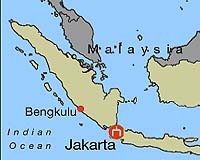| . |  |
. |
Jakarta (AFP) Aug 23, 2009 Powerful earthquakes that have jolted Asia recently do not presage a disaster, although it is only a matter of time before the next catastrophe befalls the quake-prone region, seismologists say. From India to Japan, Indonesia and as far south as New Zealand, the region has been rattled by what appear to be a connected spate of strong quakes in the past few weeks. Luckily they have caused little damage and few casualties, but for people living in countries straddling the so-called "Pacific Ring of Fire" of major fault-lines, each new tremor raises the question: when will the "big one" hit? The bottom line is that earthquakes are impossible to predict and, while catastrophic quakes are inevitable, no one can say when they will strike. Japan in particular has been bracing itself for an expected magnitude-eight quake believed most likely to strike in the Tokai region near Tokyo. People even have a name for the anticipated disaster: the Tokai Quake. "Series of earthquakes can often be monitored, but last week's earthquake does not appear to be a sign pointing to the 'big one'," Tokyo University honorary professor of seismology Ryohei Morimoto told AFP, referring to a 6.6-magnitude quake that struck Japan on August 17. Around 20 percent of the world's most powerful earthquakes strike Japan. The megacity of Tokyo in particular sits on the intersection of three continental plates -- the Eurasian, Pacific and Philippine Sea plates. The last time a "big one" struck Tokyo was in 1923, when the Great Kanto Earthquake claimed more than 140,000 lives, many of them in fires. Previously, in 1855, the Ansei Edo quake also devastated the city. Experts say quakes in particular areas may be related, but they see no link between quakes on different boundaries of tectonic plates, such as the huge 7.5-magnitude tremor that shook the Andaman Islands in the Indian Ocean and the 6.4-magnitude quake that hit Japan almost simultaneously on August 11. D. Srinageswar, a senior seismologist with India's National Geophysical Research Institute based in the southern city of Hyderabad, said scientists simply did not know enough about the movements of the earth's crust to be able to predict when and where the next cataclysmic event would take place. "Prediction of a quake in time is not possible. The process will need data going back hundreds or even thousands of years," he explained. "It was only in 1960 that instruments came up that helped understand at what depths the quakes occur, the magnitude of the quakes.... Spatially we know where it is going to happen, but in time we can't say." Indonesian Meteorology and Geophysics Agency technical chief Suharjono likened the tectonic shifts of the earth's surface to a speeding car. "There was a big 6.9-magnitude quake in Sumatra recently, followed by aftershocks. The aftershocks aren't unusual... they happen so that a new stability can be achieved," he said. "Just like putting a brake on a speeding vehicle, it will wobble a little as it tries to stabilise itself. It's the same with earthquakes." Suharjono said it might look like there had been a lot of quakes recently but the numbers from year to year were stable. "About 5,000 to 6,000 quakes over a magnitude of 4.5 take place in the Indonesian region every year, this number hasn't changed," he said. "If the concern is because of what's been happening recently, I'd say there's no need to worry." The apparent spate of quakes is nothing unusual, but they have fuelled debate over whether seismic activity can be considered a precursor to a bigger one in the same region, or whether it reduces the risk by releasing tectonic pressure. "When there is a large earthquake, it will release stress on that part of the system but it might transfer some of that stress to another part which might bring forward another earthquake," said Ken Gledhill, a government seismologist in New Zealand where a giant 7.8-magnitude quake hit on July 15. "This will happen every now and again where there appear to be a group of earthquakes near in time if not in space. That's bound to happen -- these earthquakes happen all the time." burs-smc/jw Share This Article With Planet Earth
Related Links Bringing Order To A World Of Disasters When the Earth Quakes A world of storm and tempest
 Listening To Rocks Helps Researchers Better Understand Earthquakes
Listening To Rocks Helps Researchers Better Understand EarthquakesChampaign IL (SPX) Aug 21, 2009 When Apollo punished King Midas by giving him donkey ears, only the king and his barber knew. Unable to keep a secret, the barber dug a hole, whispered into it, "King Midas has donkey ears," and filled the hole. But plants sprouted from the hole, and with each passing breeze, shared the king's secret. Earth, as it turns out, has other secrets to divulge. From the pounding of the surf and ... read more |
|
| The content herein, unless otherwise known to be public domain, are Copyright 1995-2009 - SpaceDaily. AFP and UPI Wire Stories are copyright Agence France-Presse and United Press International. ESA Portal Reports are copyright European Space Agency. All NASA sourced material is public domain. Additional copyrights may apply in whole or part to other bona fide parties. Advertising does not imply endorsement,agreement or approval of any opinions, statements or information provided by SpaceDaily on any Web page published or hosted by SpaceDaily. Privacy Statement |